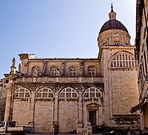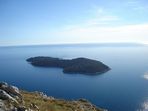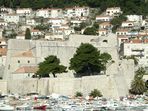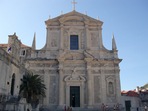Dubrovnik
Dubrovnik is situated at the very south of the Republic of Croatia and offers an unusual blend of modern culture and established tradition. Polished marble streets, a labyrinth of alleyways and breathtaking architecture characterize the Old Town. Dubrovnik’s most stunning feature is the 82-foot tall city wall, which extends more than a mile. "Those who seek paradise on earth should come to Dubrovnik" George Bernard Shaw once remarked.
The magnificent sight of the Old Town jutting into the azure sea makes it clear why Dubrovnik is known as the pearl of the Adriatic. In the 14th century, Dubrovnik was the only eastern Adriatic city-state to rival Venice enjoying sovereignty and its own culture. Indeed, with the first step on the wide Stradun stretching towards the bell tower, there can be no doubt as to the power that the Republic’s 450 years of independence have brought. Although severely damaged by an earthquake in 1667, Dubrovnik managed to preserve its beautiful Gothic, Renaissance and Baroque churches, monasteries, palaces and fountains. UNESCO recognized the rich cultural heritage and entered the city into its World's Heritage List.
Dubrovnik is situated at the very south of the Republic of Croatia and offers an unusual blend of modern culture and established tradition. Polished marble streets, a labyrinth of alleyways and breathtaking architecture characterize the Old Town. Dubrovnik’s most stunning feature is the 82-foot tall city wall, which extends more than a mile. "Those who seek paradise on earth should come to Dubrovnik" George Bernard Shaw once remarked.
The magnificent sight of the Old Town jutting into the azure sea makes it clear why Dubrovnik is known as the pearl of the Adriatic. In the 14th century, Dubrovnik was the only eastern Adriatic city-state to rival Venice enjoying sovereignty and its own culture. Indeed, with the first step on the wide Stradun stretching towards the bell tower, there can be no doubt as to the power that the Republic’s 450 years of independence have brought. Although severely damaged by an earthquake in 1667, Dubrovnik managed to preserve its beautiful Gothic, Renaissance and Baroque churches, monasteries, palaces and fountains. UNESCO recognized the rich cultural heritage and entered the city into its World's Heritage List.
Dubrovnik Cathedral
The Assumption Cathedral (Croatian: Katedrala Velike Gospe, Katedrala Marijina Uznesenja) is a Roman Catholic cathedral in Dubrovnik, Croatia. It is the seat of the Diocese of Dubrovnik.
The cathedral was built on the site of several former cathedrals, including 6th, 10th and 11th century buildings, and their 12th century successor in the Romanesque style, which was largely destroyed in the earthquake of 1667. The Senate of Dubrovnik appealed to the architect Andrea Bufalini who sent a model for the new church. Several other Italian architects including Francesco Cortese (present from 1669 until his death in 1670), Paolo Andreotti (present 1671-1674), Pier Antonio Bazzi (present 1677-78), and Tommaso Maria Napoli of Palermo (present 1689 - 1700), all working with local and imported stonemasons,completed the Cathedral over the next three decades
The Assumption Cathedral (Croatian: Katedrala Velike Gospe, Katedrala Marijina Uznesenja) is a Roman Catholic cathedral in Dubrovnik, Croatia. It is the seat of the Diocese of Dubrovnik.
The cathedral was built on the site of several former cathedrals, including 6th, 10th and 11th century buildings, and their 12th century successor in the Romanesque style, which was largely destroyed in the earthquake of 1667. The Senate of Dubrovnik appealed to the architect Andrea Bufalini who sent a model for the new church. Several other Italian architects including Francesco Cortese (present from 1669 until his death in 1670), Paolo Andreotti (present 1671-1674), Pier Antonio Bazzi (present 1677-78), and Tommaso Maria Napoli of Palermo (present 1689 - 1700), all working with local and imported stonemasons,completed the Cathedral over the next three decades
Lokrum
Lokrum or Lacroma is one of the islands, off the city of Dubrovnik about 600 metres from the coast stretching from the northwest to the southeast, in the Adriatic Sea, Croatia. Its highest point above sea level is at 96 m.
The Austrian archduke (and short-lived Emperor of Mexico) Maximilian once had a holiday home on the island. A monastery and a botanical garden survive from his era. On this peak stands Fort Royal Castle, which was built by the French, though it was later named "Maximilian's Tower" by the Austrians.
On the eastern side of the island, protected from the open sea, there is a small natural harbour. The island covers an area of 0.8 km² and is covered in thick Mediterranean flora and woods: laurel, oak, pines, cypress and black pines. There are also olives, agaves, cacti, magnolia and palms. On the southern part of the island there is a small salt lake, 10 m deep, known as "the Dead Sea" (Mrtvo More). Nearby there is a deserted Benedictine monastery, founded in 1023. The triple-naved basilica, and a 14th century part of the monastery were badly damaged in the 1667 earthquake. The monastery was deserted in 1798. Today Lokrum is a Nature Reserve and a Special Forest Vegetation Reserve.
Lokrum or Lacroma is one of the islands, off the city of Dubrovnik about 600 metres from the coast stretching from the northwest to the southeast, in the Adriatic Sea, Croatia. Its highest point above sea level is at 96 m.
The Austrian archduke (and short-lived Emperor of Mexico) Maximilian once had a holiday home on the island. A monastery and a botanical garden survive from his era. On this peak stands Fort Royal Castle, which was built by the French, though it was later named "Maximilian's Tower" by the Austrians.
On the eastern side of the island, protected from the open sea, there is a small natural harbour. The island covers an area of 0.8 km² and is covered in thick Mediterranean flora and woods: laurel, oak, pines, cypress and black pines. There are also olives, agaves, cacti, magnolia and palms. On the southern part of the island there is a small salt lake, 10 m deep, known as "the Dead Sea" (Mrtvo More). Nearby there is a deserted Benedictine monastery, founded in 1023. The triple-naved basilica, and a 14th century part of the monastery were badly damaged in the 1667 earthquake. The monastery was deserted in 1798. Today Lokrum is a Nature Reserve and a Special Forest Vegetation Reserve.
Revelin Fortress
In the period of unmistakable Turkish danger and the fall of Bosnia under Turkish rule, a detached fortress providing additional protection to the land approach to the eastern Ploče Gate was built to the east of the city in 1462. The name Revelin derives from rivelino (ravelin), a term in military architecture which refers to work built opposite the city gate in order to afford better protection from enemy attack.
Danger of Venetian assault suddenly increased in the times of the First Holy League, and it was necessary to strengthen this vulnerable point of the city fortifications. The Senate hired Antonio Ferramolino, an experienced builder of fortresses in the service of the Spanish admiral Doria, a trusted friend of the Republic. In 1538 the Senate approved his drawings of the new, much stronger Revelin Fortress. It took 11 years to build it, and during that time all other construction work in the city had stopped in order to finish this fortress as soon as possible.
In the period of unmistakable Turkish danger and the fall of Bosnia under Turkish rule, a detached fortress providing additional protection to the land approach to the eastern Ploče Gate was built to the east of the city in 1462. The name Revelin derives from rivelino (ravelin), a term in military architecture which refers to work built opposite the city gate in order to afford better protection from enemy attack.
Danger of Venetian assault suddenly increased in the times of the First Holy League, and it was necessary to strengthen this vulnerable point of the city fortifications. The Senate hired Antonio Ferramolino, an experienced builder of fortresses in the service of the Spanish admiral Doria, a trusted friend of the Republic. In 1538 the Senate approved his drawings of the new, much stronger Revelin Fortress. It took 11 years to build it, and during that time all other construction work in the city had stopped in order to finish this fortress as soon as possible.
Collegium Ragusinum
The building adjacent to the Church is the famous Dubrovnik college Collegium Ragusinum.
The Jesuits came to Dubrovnik in the first half of the 16th century aiming to open a Jesuit College, which they accomplished as late as 1658. After the Jesuit Order had been abolished in 1773, the Collegium was taken over by the Piarists.
The building now houses a classical grammar school. The old library includes over 10.000 volumes with valuable incunabula and manuscripts by Dubrovnik writers.
The building adjacent to the Church is the famous Dubrovnik college Collegium Ragusinum.
The Jesuits came to Dubrovnik in the first half of the 16th century aiming to open a Jesuit College, which they accomplished as late as 1658. After the Jesuit Order had been abolished in 1773, the Collegium was taken over by the Piarists.
The building now houses a classical grammar school. The old library includes over 10.000 volumes with valuable incunabula and manuscripts by Dubrovnik writers.
The Rector's Palace
Between the Town Hall and the Church of St. Blaise on one side and the Cathedral on the other side the Rector's Palace, an outstanding monument of secular architecture, is found.
The Rector's palace is a harmonious Gothic and Renaissance palace with certain Baroque additions. The palace owes its present shape to many additions and reconstructions throughout its turbulent history. From time to time it happened that the palace was destroyed or heavily damaged by either fires, gunpowder explosions or earthquakes which required a total or partial reconstruction or repair of the building. Each architect had its own view of how the building should look so nowadays we can enjoy the unique mixture of styles blended perfectly across this monumental structure.
Between the Town Hall and the Church of St. Blaise on one side and the Cathedral on the other side the Rector's Palace, an outstanding monument of secular architecture, is found.
The Rector's palace is a harmonious Gothic and Renaissance palace with certain Baroque additions. The palace owes its present shape to many additions and reconstructions throughout its turbulent history. From time to time it happened that the palace was destroyed or heavily damaged by either fires, gunpowder explosions or earthquakes which required a total or partial reconstruction or repair of the building. Each architect had its own view of how the building should look so nowadays we can enjoy the unique mixture of styles blended perfectly across this monumental structure.













